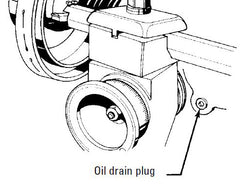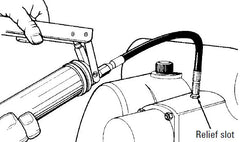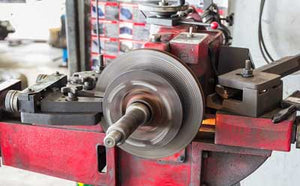By Dave Monyhan (retired)
Brake lathes are expensive machines and yes, they are heavy duty and durable and are designed to last a long time. They do, however, need some tender loving care and at times some serious maintenance.
Whether you have an Ammco, Van Norman, or FMC or any other brand of brake machine they all need some basic attention and spring time is the best time to get that maintenance done before your busy season is upon you. Before I get started, I want to give a quick shout out to Ammco for the helpful information in their operation manual and for the great illustrations you'll see below.
Let’s start with a thorough cleaning on the outside.
I hear ya, why clean a machine that is just going to get dirty again? Because you have pride in your shop and I don’t know why, but a clean machine just seems to run better. Now don’t go grab the air hose and start blowing crap all over your shop. You could cause an eye injury by blowing chips all over the shop. Plus you could drive a chip or dust particle into a place like a seal and you do NOT want that to happen.
Wipe the machine down with a simple degreaser. Let’s also make sure to empty the chip tray. Here is where you can score some points if you have a family flower garden - the cast iron brake chips will enhance anyone’s garden by adding iron right into the soil, making your roses even bigger and more colorful. Next clean the chip shield so you can see through it or replace as necessary. Inspect your work light and look for any frayed electrical cords and maybe replace the light bulb as well.
Now it is time to check the oil and other lubes.


Most gear boxes, including the variable speed and disc brake feed do not require lubricant but always check your owner’s manual for the specifics on your machine.


Inspect the Boots and Belts
 When you have the machine all cleaned and lubricated let’s do a walk around inspection. Look closely at the various protection boots/bellows for any cracks, breaks or slits as these will allow dust and metal chips to get into places we don’t want dust and metal chips to be. Replace the boots as necessary. Inspect all the drive belts for cracks. If you have a serpentine belt, look to be sure all of the grooves are still present. If not, replace the drive belts. They are not that expensive and having one break during a job will surely cost you additional time on that job, waiting for replacement belts to arrive.
When you have the machine all cleaned and lubricated let’s do a walk around inspection. Look closely at the various protection boots/bellows for any cracks, breaks or slits as these will allow dust and metal chips to get into places we don’t want dust and metal chips to be. Replace the boots as necessary. Inspect all the drive belts for cracks. If you have a serpentine belt, look to be sure all of the grooves are still present. If not, replace the drive belts. They are not that expensive and having one break during a job will surely cost you additional time on that job, waiting for replacement belts to arrive.
Check Your Tooling, Adaptors, Cones, Bell clamps, Nuts & Washers.
Let’s start with the arbor. Remove the arbor from the machine. Now set the arbor up on some center blocks so you can rotate it smoothly. Adjust your dial indicator and read any run-out from the dial indicator. If you see more than .001” either straighten it or replace it. If everything checks out reinstall the arbor into the machine and use a magnetic based dial indicator and confirm you have the same reading. Sometime a chip or debris can become lodged in the receiving end of the arbor and that will cause the arbor to cock or be installed with run-out past .001”. Be sure to clean this prior to reinstalling and using the arbor.
Manually move the cross slide for your rotor cutter assembly or twin-cutter as it is also referred to. Make sure this unit travels smoothly and without any bind. Adjust as necessary to insure a nice smooth movement. Check your owner’s manual for details on this adjustment.
Next inspect the cones and adaptors for any nicks or flat spots. Take a file or fine stone, and file those nicks away. This is also a good time to go ahead and organize your tool board so you can easily and quickly set up for the various jobs coming into your shop. Set up your cones by size, smallest to largest. Do the same with your arbors nuts and washers and get into a routine to clean and inspect every cone after each use.
You probably have a variety of silencer bands on that tool board as well. Most of these are made from surgical rubber and can become contaminated with oils, grease and as well as dirt from your hands. The oils can actually cause these silencer bands to fatigue and break when you stretch them over a drum and rotor. They can even cause an injury when that break happens. Replace as needed. Note: there are new “neoprene” silencer bands and in my opinion they are worth the extra dollars. I suggest you store these and hang them from the buckle end in a vertical manner.
See instructions on Brake Lathe Boot Removal.
Remember a clean and well organized machine is happy and productive machine that will make you money and keep running day after day with simple maintenance.
As always, if you have any questions about this or any other technical topic, contact the Goodson Tech Services Department by phone (1-800-533-8010) or email.
Related Products

